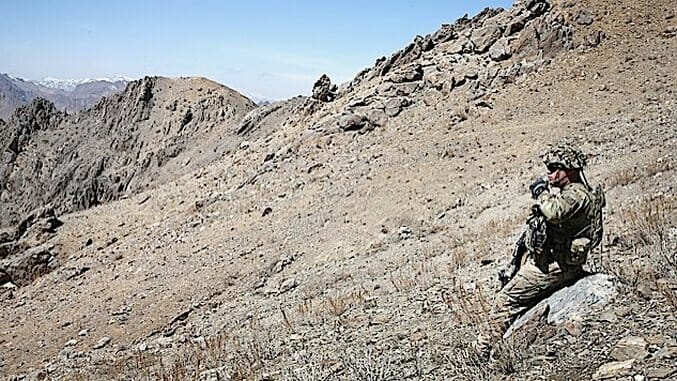President Trump appears to have decided on his Afghanistan strategy; he will proceed with the forever war. Or so it was announced on Tuesday this week. The Afghanistan conflict, which began shortly after the events of 9/11, is easily the longest war in American history; if it lingers on until the next election, it will have lasted an entire generation.
According to Reuters:
The U.S. Air Force may intensify its strikes in Afghanistan and expand training of the Afghan air force following President Donald Trump’s decision to forge ahead with the 16-year-old war, its top general told Reuters on Tuesday. Air Force Chief of Staff General David Goldfein said, however, he was still examining the matter, as the U.S. military’s top brass had only begun the process of translating Trump’s war strategy into action. Asked whether the Air Force would dedicate more assets to Afghanistan, where the United States has been engaged in its longest military conflict, Goldfein said only: “Possibly.”
The war-ravaged nation was conquered by the United States during Bush’s first term. America has occupied the country ever since. We took it from the Taliban, who we funded in the Eighties to fight the Soviets, who invaded the country on Christmas Eve of 1979. The battle with the Communists lasted nine years. Between the two Cold War powers, the nation has not known peace since the middle of the century, if then.
Before it was a battleground for economic systems, Afghanistan was used as a staging ground for the intrigues of the British and Russian empires in the 19th century. Trump’s recent turn-around—if it is that—is another case of conqueror’s confusion, in one of the most strife-ridden parts of the world. We have made Afghanistan what it is today.
The new administration favors the blind fumbling aggression of the Obama years. Reuters again:
In a speech on Monday night, Trump appeared to answer a call from the top U.S. commander on the ground for thousands of more troops to break a stalemate with Taliban insurgents, on top of the roughly 8,400 now deployed in Afghanistan. Trump said the United States would not disclose troop numbers, but one U.S. official told Reuters they could start moving quickly. U.S. Defense Secretary Jim Mattis said on Tuesday he would set troop levels following the review by military chiefs.
The Taliban has regrouped and reasserted itself since the 2001 invasion, and are once again a force to deal with.
According to the Times, Trump’s plan does not inspire tidal waves of hope among the experienced:
Ever since 2008, when Adm. Mike Mullen, then chairman of the Joint Chiefs of Staff, said “we can’t kill our way to victory,” the cornerstone of American policy in Afghanistan has been not about obliterating the Taliban but pummeling them toward peace talks. President Barack Obama’s Afghan surge, which brought the American force to 100,000 troops, failed to do this. In his speech Monday night, Mr. Trump asserted that the United States would yet achieve peace through victory. Despite that assertion, and far more modest troop commitments this time, the hope of tiring the Taliban remains the mantra repeated by American diplomats and the generals whom the president has empowered to execute his policy.
The officials who would theoretically be tasked with enacting any Trumpian plan are balking at the President’s rhetoric.
They have quietly repeated that hope even in the absence of any visible peace process since the latest serious effort at talks collapsed last year. Within hours of Mr. Trump’s speech, the American military commander in Kabul made that clear. … As might be expected, the Taliban spokesman, Zabihullah Mujahid, scoffed at Mr. Trump’s speech as “nothing new.” But many Afghans on the government side had a similar take. “That’s the same strategy going on the last two decades,” said Jamaluddin Badr, a member of the Afghan High Peace Council. “He said we’re going to win, but he didn’t make it clear how we’re going to win.”
Let us speak frankly. Based on what we know of his government career thus far, Trump is a man made of words, and nothing else. He talks, never walks. Trump may send additional military forces, but what will he really do? We already have a substantial presence there.
According to NBC, our presence there is greater than our government lets on:
The average number of U.S. troops serving in Afghanistan at any given time is thousands more than the Pentagon officially acknowledges, according to three U.S. defense officials. The Pentagon officially acknowledges 8,400 troops on the ground there, but that number actually hovers between 11,000 and 12,000, the officials said. The actual force manning level is 8,448, which is the maximum number of U.S. service members who are authorized to be assigned to either Resolute Support or U.S. Forces Afghanistan, the two military missions there.
He can bomb them more—no luck; we’ve been doing that for a while. We dropped the largest non-nuclear bomb we could on them, and we still arrived at this fork in the road. He can send many, many more troops over there—unlikely, and no draft will arrive. He can spend more money—if Congress will give it to him. He can prop up the current Kabul government—again, same project as before. With the same problems. The Times again:
Even if the new American troop commitment limits the Taliban to the territory they have seized in the past two years, the pressure of that advance and old political rivalries have brought the Afghan government to the brink of collapse.
Or we might accept the fact that Afghanistan is broken for a hundred years, and that our business was done when we killed Bin Laden. We must either radically redefine what we are doing in Afghanistan—commit to spending billions of dollars in real infrastructure projects—or pull out entirely. This is not our country. What are we doing there?
